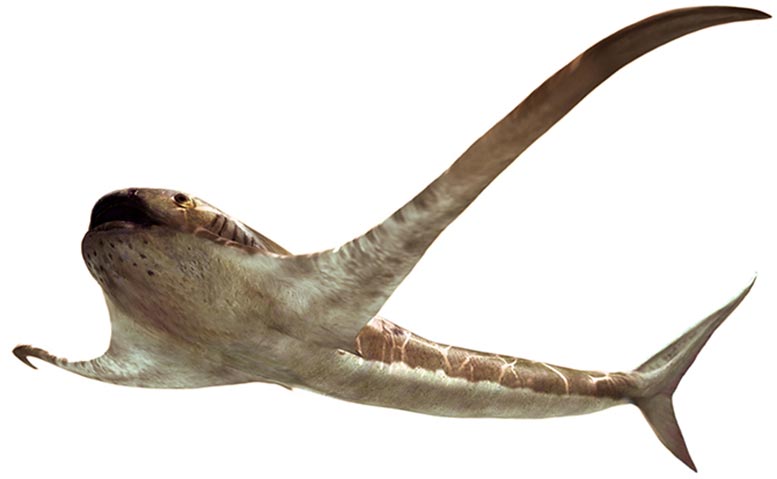
Artist’s impression showing one eagle shark. Credit: © Oscar Sanisidro
Introducing a “bizarre” shark from the Late Cretaceous that, more than 66 million years ago, plied the seas feasting upon plankton while soaring through the water on long, slender fins.
In a new study, Romain Vullo and colleagues describe this new species of manta-like planktivorous shark, dubbed Aquilolamna milarcae, from the creatures’ fossilized remains discovered in northern Mexico. The findings reveal an unexpectedly early evolutionary experimentation with underwater flight among sharks predating the rise of similar traits in manta rays and devilfish by more than 30 million years.
Elasmobranchs — the highly successful group of cartilaginous fishes including sharks, skates and rays — first appeared in Earth’s oceans roughly 380 million years ago and have since evolved to fill a diverse array of ecological roles. Modern plankton-feeding elasmobranchs are characterized by two distantly related clades — those with a more “traditional” shark-like body shape, such as whale and basking sharks, and those with the sleek, flattened bodies and winglike fins of Mobulidae rays.

Fossil of the Aquilolamna milarcae shark found in the limestone of Vallecillo (Mexico). Credit: © Wolfgang Stinnesbeck
Standing out among both living and fossil planktivorous sharks and rays, Aquilolamna milarcae resides somewhere in-between. According to Vullo et al., the newly discovered extinct species displays many manta-like features, including unusually long, slender pectoral fins and a wide mouth seemingly adapted to filter-feeding. However, the winged shark also had an elongated, torpedo-like body and tail, culminating in a distinct caudal fin like many other shark species.
The fossils indicate that the unique elasmobranch was a relatively slow swimmer, using both its long pectoral fins and tail to glide through the water while scooping up suspended plankton using its large, gaping mouth. What’s more, the findings demonstrate that winglike fins evolved independently in each main lineage of filter-feeding elasmobranchs.
For more on this discovery, read Discovery of a Bizarre, Winged “Eagle Shark” in the Cretaceous Seas.
Reference: “Manta-like planktivorous sharks in Late Cretaceous oceans” by Romain Vullo, Eberhard Frey, Christina Ifrim, Margarito A. González González, Eva S. Stinnesbeck and Wolfgang Stinnesbeck, 18 March 2021, Science.
DOI: 10.1126/science.abc1490









